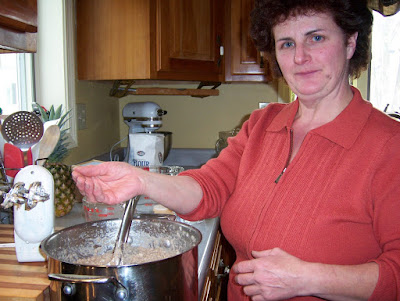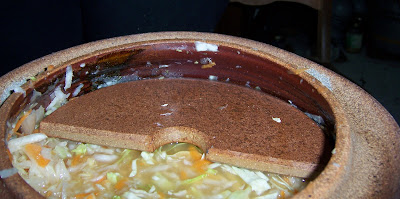
Every culture, every country, every cuisine, has some kind of meat pie. Just think of that old nursery rhyme, “Four and twenty blackbirds baked in....” one. Think of calzone, knish, pizza, shepherds, chicken pot, steak and kidney, pasty, empanada...
The first time my neighbor and friend Ginette Turgeon mentioned tourtière, my ears pricked right up and I peppered her with incessant questions about the thing. She told me she’d grown up with it in Québec, that it was a French Canadian meat pie enclosed in two crusts. That only enflamed my curiosity, perhaps because mincemeat pie, as my grandma made it and as I do now, is one of my favorite things in the world. Mincemeat, not many people know, is beef, or venison neck meat if Grandma had her way, chopped up with suet, apples and raisins, with brown sugar, cinnamon, cloves, nutmeg, and pepper added, all simmered together until done. About two hours. Enclosed in two crusts and baked.
If tourtière didn’t sound more exotic, it was interesting in that it was connected – there was boiling meat, and sweet spices like cloves. It differed from mincemeat, and put it in a whole other category, that there was whipping, and a potato, and no sugar. “Not sweet. No,” Ginette said. “It is a savoury pie.” But, like mincemeat again, “and we eat it at Christmas and at New Years and at no other time.”
Many years have flown by since that first conversation, and though Ginette and I have talked about tourtière several times during those years I had never tried making it. This year I was spurred on by a reader and neighbor, Mickey Best, asking about tourtière last spring and lamenting that she could not seem to make it taste the way it used to. I remembered this lament when another friend and neighbor, Lowell Klock, came back, from spending Thanksgiving in
I looked up recipes on the web and combined a few and made it. I liked the idea I found of simmering the ground pork in milk, quite a lot of milk. Some recipes had no spices – I went with the classic four – cloves, cinnamon, allspice and pepper – not a lot of each. That was about it. Sauté the meat until the red is out – until it’s gray – add the spices, and the milk just to cover, some salt, and let simmer for about 2 hours. I scraped it all into a container and refrigerated it. It was very good, but not quite as formed, as... stiff, as the slice that
So that was a success. We ate some with toast, I gave some to Ginette (but none to
I’m not sure if
Damned tasty, though, if we do say so, in a way to which much of today’s food cannot begin to aspire: in its history, its outdated necessity, and the almost-from-Marco-Polos-era – or at least 17th Century France – way of spicing meat with sweet spices – the better to preserve it longer, or at least smell like it; in the use of milk, I think, as the original simmering medium to make a kind of gravy of the very meat!; and the pastry enclosure to render that creton handy to transport down into the mines or up into the pastures. At which time, enclosed in pastry, it becomes pasty, tart, burrito, well, you get the point. Tourtière is not quite as handy to carry, but the pastry crust does make it more festive at the table.
Having a pound and a half of ground beef on my hands, I decided to make a tourtière out of it instead of pork, a legitimate decision because most surmise tourtière was a way of using leftovers. In fact, a cipâte, from Saguenay-Lac-Saint-Jean, widely thought to be a predecessor of tourtière, uses several different kinds of meat, notably wild ones, each layer separated from the next, sometimes by pastry. Gaspé, being a fishing area, makes a salmon pie or tourtière, as well as a chicken one. The Québécois version sometimes uses veal and/or beef in addition to pork.
Adding a little lard to the heavy pan to grease it, I cooked the ground beef, with a chopped medium-sized onion and several cloves of garlic. When it was gray and limp – how appetizing! – I added ¼ teaspoon each of cinnamon, nutmeg, allspice and pepper, maybe a teaspoon of salt, a rather large potato cut in 1 inch chunks, poured in enough whole milk to cover it – about a cup and a half – brought it to a simmer, put the cover on and let it cook for about 2 hours, until it was thick and most of the milk had been absorbed. Then, remembering, however vaguely, Ginette saying that she beat it, I mashed it with a potato masher to get out all the clumps of meat until it was of a rather fine consistency. Then I corrected the seasonings – it needed a little more salt.
I made my usual crust of 2 cups flour, a little more salt than usual –a heaping teaspoon of flaky seasalt, 1/3 cup butter and 1/3 cup lard, and 1/3 cup water or a little less. Once the pastry was rolled out and filled with the cooled meat, I glazed the top crust with 1 egg yolk mixed with a little cream, and baked it at 450 for 15 minutes, then 350 for another half an hour. With all due modesty, I have to say that crust was the best one I’ve ever made. Man, it was toothsome!!!
I had a feeling I should serve the tourtière with gherkins, the traditional accompaniment to creton, but I didn’t have any, so I dolloped several things around it – horseradish made by Mama K (another
But to get the ultimate low-down on tourtière, I asked Ginette if I could stop by and observe her technique. She makes half a dozen pies and freezes them without baking them, then takes them out one by one during the holiday season to bake. Her whole family looks forward to them. Knowing how these things work, she had made one tourtière for me to see the finished product – and a beautiful thing it was – while on the stove bubbled the makings for another five or six pies.
She was using ground pork, about 1 ½ pounds per pie, with one large onion and 5 to 6 cloves of garlic, chopped pretty finely, adding 1 teaspoon of salt and some pepper, which she cooks just until the meat loses its red color, then covers this with the water, not milk, about 1 ¼ cups, and simmers it for about an hour and a half or until reduced and almost creamy. Only then does she add her spices – about ¼ teaspoon each of cloves and cinnamon, and simmers it another 20 minutes. Remember, this is for one tourtière.
And Ginette does not kid when she says she beats it – she gets out her handy hand-mixer and whips the meat, for some time. “I whip it to not a fine texture, not exactly a spread,” she says, “but so it is all even, and until the water is all incorporated. I don’t like coarse!”
Only when she approves its texture, does she add the potato. “I use one very large potato, russet, starchy, for each pie, and I cook it and mash it without any butter or milk before I add it to the meat.” She dollops in the potato and whips it into the meat, and then checks the seasoning. “Oh, more salt!” she exclaims, “and a little more cinnamon.” She sprinkles more salt, and we taste, and she sprinkles a little more salt. “Now, what do you think? It’s perfect, eh?” And it was.
“What did you serve with it,” she asked. I went on and on about what I’d tried, and that I’d settled on Greene’s Hot Chipotle Sauce, and returned the question to her. “Plain,” she said decidedly. “I like mine plain, but Gaeton likes zucchini relish with it.” I recalled Ginette mentioning last summer that she always made a little zucchini relish for her husband Gaeton to eat with tourtière come Christmas. I recalled that in my research traditional sides are pickled beets or green tomato relish.
At my request, Ginette flipped through her books – most of them in French – to find the recipe she uses for creton. It calls for 2 pounds ground pork, two onions and 2 cloves of garlic, chopped, 2 cups water, 2 teaspoons salt, to be simmered together for 1 hour; at which time 1 cup of milk, ½ cup of oatmeal and ½ teaspoon of allspice are added and cooked for another hour. That’s whipped, too, before being packed into a dish and refrigerated.
The oatmeal I had not heard of before, but that and the potato in the tourtière are thought by food historians to reflect an Irish influence. Looking for the original recipe for something? You’d probably have to go back to the apple in the garden of Eden.
Well, that’s about all I know about tourtière, as well as creton. I’m glad I finally know it, though – it’s delicious, it’s beautiful and impressive, it’s traditional, it’s easy to prepare, can all be done ahead, and it will be a glad addition to my holiday table henceforth!
Originally published in the Rutland (VT) Herald on 12/18/07




